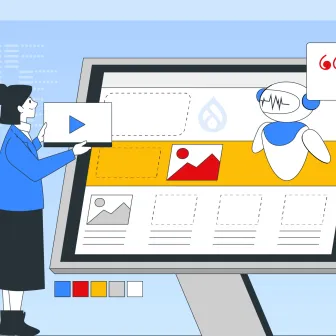Agile analytics focuses on finding value in a data set rather than deriving unlimited number of business derivations out of the data sets.
Agility in business intelligence had one agenda behind it, analytical flexibility and adaptability to changing needs rather than sticking to a rigid structure. Agile analytics has been derived from this concept and it offers a cross flow of data discovery while rapidly adhering to the present and forecasted business landscape.
Agile’s foundation is providing or deriving value, whether in a development lifecycle or a business intelligence platform.
What are some benefits agile brings to the table?
- Everyone feels equally responsible for product quality
- The results of every iteration allows users to share feedback and rapidly implement changes to cater to stakeholder requirements and adapt the development for the future carousel
- It is also known to bring down product costs by implementing the scale-out version of the system across various independent functions.
- Agile analytics allows is deeply known for being self service oriented, with less dependence and distributed talent, it becomes quite the learning curve.
What is traditional analytics methodology ?
Analytics projects have been tougher to manage than the rest of the product lines. They have always been the most challenging of the breed.
Like every other project, digital analytics project has an initiation and completion date but requirements seem to never end from the client or stakeholder end. There is always something or the other which makes up for the time and extends the projects by 2-3 sprints.
Every person has roles and responsibilities assigned in an ordinary fashion often leads to too much of rework, and the traditional waterfall methodology does not seem to work for controlling the project.
In case digital analytics projects wouldn’t have come across, the importance of agile and it’s methodologies wouldn’t have been understood so well. This is very much in line with the ever changing digital and analytical world.
Before going agile on analytics, understand how is it different.
Analytics teams often struggle choosing between the traditional sequential but inflexible Waterfall methodology and Agile, which has created a lot of turbulence in analytics teams as it is more adaptable to changes.
Waterfall brings planning into play, Agile assumes changes to keep happening.
Waterfall tends to ascertain client or stakeholder end requirements very early on in the project’s stage. The requirement gathering done during the initial stages defines the pace and complexity of the product and any to and fro or changes tend to be to changes afterwards.
On the other hand, Agile allows for changes even at advanced stages, agile focuses more on creating a Minimum Viable Product as early as possible in the project timeline and the rest of time is spent in defining the further scope and ascertaining the bottlenecks in delivering complex solutions on the business end. With the help of continuous feedback from the stakeholders the project is able to catch pace in the right direction.
Waterfall runs serially, Agile runs in parallel.
A Waterfall project is typically divided into multiple phases as per the stakeholder’s requirements. Those phases then have respective milestones and they are considered stronger milestones in themselves. Many phases may run parallelly while some can run serially as per the projects functional and nonfunctional requirements.
This means that a phase cannot start until one is completed. In waterfall, the projects are divided into mini sprints which run across two consecutive weeks and they are their mutually agreed upon deliverables. However, Agile mounts the project into consecutive sprints which typically last two weeks, they have clear deliverables and are focused on improving the model based on business users’ feedback.
Waterfall tests at the end, Agile tests throughout.
Testing happens at the later stages in a waterfall based project versus agile keeps testing across the major sprint completion. The testing-later approach gives the stakeholders and testing team some time to understand the project in a much more significant way.
In Agile, testing of each sprint is done while the sprint is underway, so changes are easier to implement. However, quality testers will be required throughout the project impacting cost drastically and helping deliver quality sprint results at hand.
Waterfall works for users, Agile acts as a team player.
Agile has always focussed on business user satisfaction, involves them throughout the development phase and allows frequent monitoring by them. On one side the business team is regulating requirements and priorities while the analytics team are busy sorting out the features and throwing out reports which are going to be the most impactful for businesses taking into consideration their priorities and can deliver insights accordingly.
Cost projection and estimations are better with waterfall.
Waterfall has a plannable workflow with a clear cut beginning, bottle necks and an end and so the evaluation process is comparatively easier. makes it simple to estimate costs and timelines in absence of changes. Every sprint has a fixed time duration attached to it but understanding how many sprints will be needed can be challenging since changes are allowed to happen.
Well, how to transition to Agile ?
In case you have been a long practitioner of waterfall, it is definitely a tough call to switch your process and operations to agile. Disagreements are normal and bound to happen, there might be a scenario where half your team wants to stick to a waterfall but the others want to transition to agile.
Generally stakeholders like things to be detailed and to the very pinpoint but architects and professionals like to go milestone by milestone and let things be figured out on the go. But when it comes to analytics, teams generally use hybrid development concepts rather than sticking to one, this is because the waterfall lets them to retain consistent clarity and traceability while keeping agile at times where adaptability and complexity might be extremely necessary.
What should be your team structure like?
- To function well in the agile role, analytics teams need to be configured in a way that enables members to keep adapting as per business needs members to dynamically adapt different roles.
- There should be some factors you must consider before on-boarding a team onto the agile analytics team:
- The team should either function in a fully centralised manner or in a remote collaboration concept depending on what is on the organisation's plate and will it be handled with the current role dynamics?
Once these criteria are in place, the team should move forward to making things evolve at a natural place as per the team's capacity. Resourcing levels may need to vary according to levels of demand.
Final Word
Agile analytics is considered best in some scenarios and waterfall in some but due to numerous to and fros, it is good to be on the safe side and make sure things are thoroughly tested and every proposed change makes good sense before being pushed under development.
Subscribe
Related Blogs
Inside the Drupal AI Summit: Themes, Speaker and What To Expect

“ The web is changing fast, and AI is rewriting the rules. It writes content, builds pages, and answers questions directly,…
FOST and Drupal AI Initiative: Next Era of Responsible AI

Three years after the launch of generative AI tools marked a new age for artificial intelligence, almost 90% of survey…
Drupal AI Ecosystem Part 5: AI Content Suggestions

Drupal has steadily evolved from being just a content management system into a flexible platform that incorporates emerging…




